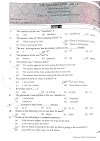Thermometry
Types of Expansion In Solids
Increase in length of the body during heating.=(1+αLΔT), where and are the length before expansion and after expansion.α is coefficient of linear expansion, ΔT is change in temperature.Also, it can be represented by ΔL/L = αLΔT (ΔL = -)
Increase in Area of the body during heating.=(1+βAΔT), where and are the area before expansion and after expansion.β is coefficient of Superficial expansion, ΔT is change in temperature.Also, it can be represented by ΔA/A = βAΔT (ΔA = -)
Increase in Area of the body during heating.=(1+γ AΔT), where and are the area before expansion and after expansion.γ is coefficient of Cubical expansion, ΔT is change in temperature.Also, it can be represented by ΔV/V = γ VΔT (ΔV = -)
The relation between α, β and ϒ α:β:ϒ = 1:2:3. α, β and ϒ solely depends only upon nature of material of body
Expansion of Liquid
Liquids have only definite volume not definite shape. Its container determines its shape. When a liquid is heated in a vessel, both the liquid and a vessel expand.
The change in volume of liquid relative to vessel is called its apparent expansion.
The real change in volume of liquid only is called real expansion(without considering expansion of vessel). Thus there are two coefficients.Also, we can write: = + Where is the coefficient of real expansion, is the coefficient of apparent expansion of liquid, and is apparent expansion of vessel.
The apparent change in volume of liquid is given by ∆ = V (ϒ - 3α)∆T.Where V is volume of liquid, ϒ is coefficient of volume expansion of liquid, α is coefficient of linear expansion of vessel.-If ϒ > 3 α, liquid level rises.-If ϒ < 3 α liquid level falls.-If ϒ = 3 α level of liquid remains stationary.
Temperature and Time Period
Δt =αΔT (Change in time period)
()*100= αΔT (Percentage change in time period)Temperature increases → Loss in time periodTemperature decreases → Gain in time period
Anomalous Expansion
The anomalous expansion of water is an abnormal property of waterwhereby it expands instead of contracting when the temperaturegoes from to . Water has maximum density (volume minimum) at 4.
The density becomes less and less as it freezes because moleculesof water normally form open crystal structures when in solid form.
Bimetallic Strip
A strip consisting of two metals of different coefficients of expansionwelded together so that it buckles on heating.
It is used as a thermostat and fire alarm.
When bimetallic strip is cooled it bends towards larger coefficient of linear expansion.
Thermal Stress
When a metal rod is heated or cooled it expands or contracts. If it is prevented fromexpansion or contraction, then stress produced is thermal stress.
== α ∆T
= Y x strain = Y α ∆T
= stress x A = Y α ∆T x A
∴ = YA α ∆T
After expansion:R’ = R(1+α∆T) ….(i)r’ = r (1+α∆T) ….(ii)
From (i) and (ii)
R’.r=r’.R=constant
Memory Tips
Two identical spheres (solid and hollow) are heated:i)By giving equal heat then hollow expand more as it has less mass.ii)By same temperature then both will expand equally.
Two rods of length and of linear expansivities & havingsame difference in temperature then .= . .
Zeroth law of thermodynamics states that “If two bodies are thermalequilibrium separately with third body then these bodies are in thermalequilibrium with each other .”
Some More
Gases have only volume expansion.When temperature of liquid increases its volume increases and density decreases.As density of substance decreases with increase in temperature sosame volume of benzene weighs less in summer than in winter but same mass ofbenzene weighs equally in summer and winter (as mass is constant).When a metallic piece is weighed in a temperature increasing liquid then its apparent weight increases.Invar is used in pendulum clock (because of low coefficient of linear expansion.If C and S are the coefficient of apparent expansion of copper and silver respectively. The coefficient of linear expansion of copper is A than silver is given by The brass disc fits tightly in a hole in a steel plate. To lose the disc we should cool the system.The correction in height of mercury level in barometer due to expansion of mercury is given by : =[1+( α –r)∆T]
Density decreases with increase in temperature = (1-r∆T)
Apparent expansion of vessel depends upon nature of liquid, orginalvolume of liquid, change in temperature and material of vessel.Real expansion doesn’t depend on expansion of vessel but depends upontemperature difference of liquid, initial volume of liquid and its nature.Water will boil when a bottle of water at zero degree Celsius opened onsurface of moon because pressure of air on the surface of moon is almostzero.



![[UPDATED] New Syllabus of IOE Entrance Examination |](https://blogger.googleusercontent.com/img/b/R29vZ2xl/AVvXsEj5C60n4l8guBTBqS4sBFaD1z9AoLPnKFQB_f1-F731bzrW_xcCsoewcBcUtqnpJhlf7lL5sOklAtsxRKdgZ-dCQiAgQb1T2X9ck-D_FYoU01fPdPA0mbsulZgmnkS-6-3Hg_CbxBExwn3z5c3-8srStMoZwr6SrmsgF5fPGjnD29T_lg1XsX3aZoIQm9k/w680/pic.png)


![[UPDATED] New Syllabus of IOE Entrance Examination |](https://blogger.googleusercontent.com/img/b/R29vZ2xl/AVvXsEj5C60n4l8guBTBqS4sBFaD1z9AoLPnKFQB_f1-F731bzrW_xcCsoewcBcUtqnpJhlf7lL5sOklAtsxRKdgZ-dCQiAgQb1T2X9ck-D_FYoU01fPdPA0mbsulZgmnkS-6-3Hg_CbxBExwn3z5c3-8srStMoZwr6SrmsgF5fPGjnD29T_lg1XsX3aZoIQm9k/w100/pic.png)


0 Comments